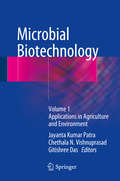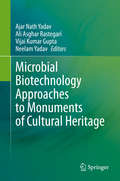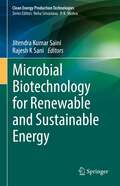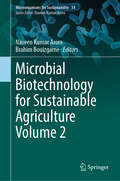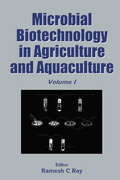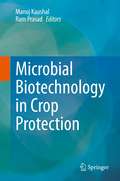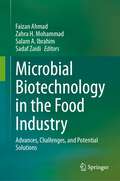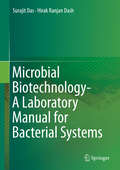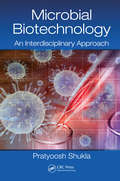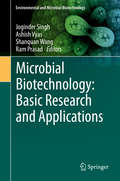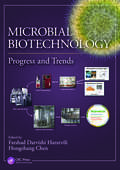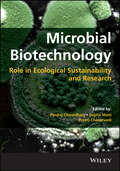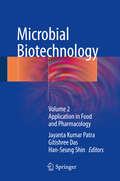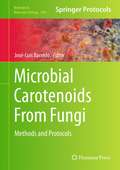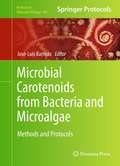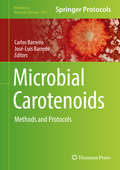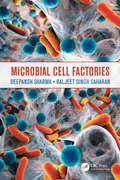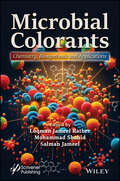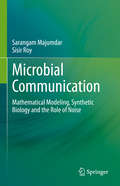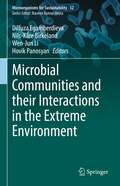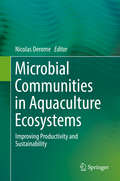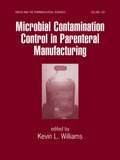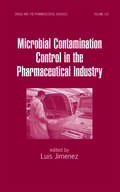- Table View
- List View
Microbial Biotechnology
by Jayanta Kumar Patra Chethala N. Vishnuprasad Gitishree DasThis edited book, is a collection of 20 articles describing the recent advancements in the application of microbial technology for sustainable development of agriculture and environment. This book covers many aspects like agricultural nanotechnology, promising applications of biofuels production by algae, advancements and application of microbial keratinase, biocontrol agents, plant growth promoting rhizobacteria, bacterial siderophore, use of microbes in detoxifying organophosphate pesticides, bio-surfactants, biofilms, bioremediation degradation of phenol and phenolic compounds and bioprospecting of endophytes. This book intends to bring the latest research advancements and technologies in the area of microbial technology in one platform, providing the readers an up-to-date view on the area. This book would serve as an excellent reference book for researchers and students in the agricultural, environmental and microbiology fields.
Microbial Biotechnology Approaches to Monuments of Cultural Heritage
by Vijai Kumar Gupta Ajar Nath Yadav Ali Asghar Rastegari Neelam YadavOur country’s cultural legacy is one of the world’s most diverse, drawing millions of visitors every year to our convents and monuments, and to our museums, libraries, concert halls and festivals. In addition, it is a dynamic trigger of economic activity and jobs. Among the various scientific branches, microbial biotechnology offers an innovative and precise approach to the complexity of problems that restorers face in their daily work. This book discusses a range of topics, including the biodiversity of microbial communities from various cultural heritage monuments, microbial biotechnological cleaning techniques, the role of bacterial fungal communities for the conservation of cultural heritage, and microbial enzymes and their potential applications as biorestoration agents. Written by internationally recognized experts, and providing up-to-date and detailed insights into microbial biotechnology approaches to cultural heritage monuments, the book is a valuable resource for biological scientists, especially microbiologists, microbial biotechnologists, biochemists and microbial biotechnologists.
Microbial Biotechnology for Renewable and Sustainable Energy (Clean Energy Production Technologies)
by Jitendra Kumar Saini Rajesh K SaniThis book covers various aspects of microbial biotechnology to produce bioenergy. It focuses on production of biofuels from plant and microbial biomass including agri-food residues and other wastes. It educates readers about various biomass resources, major aspects of production of renewable energy and fuels based on biochemical conversion routes. There is special focus on the microbial system and biotechnological processes as well as process optimization and industrial scale-up. The book brings together current challenges and potential solutions to enhance biomass to biofuel bioconversion. It is relevant for researchers, academicians, students as well as industry professionals working on biomass-based biorefineries.
Microbial Biotechnology for Sustainable Agriculture Volume 2 (Microorganisms for Sustainability #34)
by Naveen Kumar Arora Brahim BouizgarneThis book focuses on the applications of plant growth promoting microorganisms (PGPMs) in the form of bioinoculants to enhance the crop productivity and resilience against pathogens. Chapters explain the latest findings on development of the bioinoculants utilizing the modern technologies and agri-wastes. It also provides the latest information on methods of improving quality and efficiency of bioformulations and utilization of advanced biotechnological tools for developing precision products. PGPMs play important roles in survival and health of the plant. These useful microorganisms provide plants with nutrients, protect them from pathogens and help in combating abiotic stresses. It is important that these mutualistic interactions between plant and soil microbes are well understood so as to develop reliable products in the form of biostimulants, biopesticides and manage biotic and abiotic stresses in crops. Apart from enhancing crop productivity, plant-microbe interactions can also perform activities such as reclamation of degraded lands, degradation of pollutants and remediation of saline or marginal lands. This book is of interest to teachers, researchers, plant scientists and microbiologists. Also, the book serves as an additional reading material for undergraduate and graduate students of agriculture, microbiology, ecology, soil science, and environmental sciences.
Microbial Biotechnology in Agriculture and Aquaculture, Vol. 1
by R C RayIn agriculture, microbial biotechnology covers a wide array of subjects ranging from biofertilizers to biological control of pests and diseases; from biological N 2 -fixation to lignocellulose degradation; from production of biomass and biofuels to genetically engineered plants. Similarly, microbial biotechnology in aquaculture touches several aspe
Microbial Biotechnology in Crop Protection
by Ram Prasad Manoj KaushalThis edited volume is a comprehensive account of plant diseases and insect pests, plant protection and management for various crops using microbial and biotechnological approaches. The book elucidates the role of biotechnology for the enhancement of crop productivity and management of bacterial and fungal diseases via eco-friendly methods. It discusses crop–pest⁄ pathogen interaction and utilizing this interaction in a beneficial and sustainable way. This book is of interest to teachers, researchers, plant scientists and plant pathologists. Also the book serves as additional reading material for undergraduate and graduate students of agriculture, forestry, ecology, soil science, and environmental sciences.
Microbial Biotechnology in the Food Industry: Advances, Challenges, and Potential Solutions
by Salam A. Ibrahim Faizan Ahmad Zahra H. Mohammad Sadaf ZaidiBiotechnology is a promising emerging technology that uses biological systems to develop new products with broad application across medical, industrial and environmental fields. Biotechnology in the food industry provides solutions to microbial issues as well as broader environmental issues, making it key to the safe and environmentally conscious production of all food types. Microbial Biotechnology in the Food Industry focuses on the major microbial issues facing the food industry and solutions using novel biotechnology techniques. The text promotes an understanding of basic and advanced microbiological issues in food production including food products, food contact surfaces, food operation floor and air and a wide range of issues related specific solutions using biotechnology. This text provides researchers and those in the food industry with a full overview of current innovative solutions to the major microbial issues in the food industry utilizing biotechnology.
Microbial Biotechnology- A Laboratory Manual for Bacterial Systems
by Surajit Das Hirak Ranjan DashMicroorganisms play an important role in the maintenance of the ecosystem structure and function. Bacteria constitute the major part of the microorganisms and possess tremendous potential in many important applications from environmental clean up to the drug discovery. Much advancement has been taken place in the field of research on bacterial systems. This book summarizes the experimental setups required for applied microbiological studies. Important background information, representative results, step by step protocol in this book will be of great use to the students, early career researchers as well as the academicians. The book describes many experiments covering the basic microbiological experiments to the applications of microbial systems for advanced research. Researchers in any field who utilize bacterial systems will find this book very useful. In addition to microbiology and bacteriology, this book will also find useful in molecular biology, genetics, and pathology and the volume should prove to be a valuable laboratory resource in clinical and environmental microbiology, microbial genetics and agricultural research. Unique features * Easy to follow by the users as the experiments have been written in simple language and step-wise manner. * Role of each reagents to be used in each experiment have been described which will help the beginners to understand quickly and design their own experiment. * Each experiment has been equipped with the coloured illustrations for proper understanding of the concept. * Trouble-shootings at the end of each experiment will be helpful in overcoming the problems faced by the users. * Flow-chart of each experiment will quickly guide the users in performing the experiments.
Microbial Biotechnology: An Interdisciplinary Approach
by Pratyoosh ShuklaMicrobial Biotechnology: An Interdisciplinary Approach covers all aspects of microbial biotechnology, whilst bringing the field of functional foods and microbial bioremediation to the fore. Recounting the interdisciplinary scope of biotechnology and its discoveries, this text presents innovative ideas in the field of emerging biotechnology providing the scientific community with a much needed new resource. Acting as an important means of information for researchers working in interdisciplinary areas of research, this text: Envisages the recent ideas of novel findings in microbiology Provides insight into the various interdisciplinary research avenues Uniquely covers a diverse range of topics Presents groundbreaking new findings in key areas of modern biotechnology Enhanced and straight forward descriptions cater to the needs of researchers working in areas of bacterial exopolysaccharides, microalgal proteomics, applications of Microbial L-asparaginases, novel aspects of bioremediation, Probiotics and their impact on society, and microbial community analysis in waste water treatment techniques. It will also prove crucial reading for senior undergraduate and graduate students and professionals working in areas of modern biotechnology.
Microbial Biotechnology: Basic Research and Applications (Environmental and Microbial Biotechnology #1)
by Ram Prasad Shanquan Wang Joginder Singh Ashish VyasMicrobial biotechnology is an important area that promotes advanced research into using microbes for value-added products, human nutrition, and the overall wellbeing of society. This book presents the latest information on the use of microbes for sustainable development, and highlights state-of-the-art biotechnological techniques used to harness microbial biotechnological traits on a commercial scale. Gathering contributions from authoritative researchers in the field, it addresses recent advances in microbial biotechnological approaches that offer sustainable options for future generations. Exploring a broad range of microbial products and their uses, the book specifically places emphasis on the application of microorganisms in healthcare, the environment and industry. It also discusses various compound classes derived from microbial metabolites. Pursuing a holistic approach to recent advances in the utilization of various microbes as biotechnological tools, the book also covers traditional uses, and explores emerging strategies to harness their full potential. Accordingly, it offers a valuable resource for researchers and graduate students alike.
Microbial Biotechnology: Fundamentals of Applied Microbiology, Second Edition
by Alexander N. Glazer Hiroshi NikaidoKnowledge in microbiology is growing exponentially through the determination of genomic sequences of hundreds of microorganisms and the invention of new technologies such as genomics, transcriptomics, and proteomics, to deal with this avalanche of information. These genomic data are now exploited in thousands of applications, ranging from those in medicine, agriculture, organic chemistry, public health, biomass conversion, to biomining. Microbial Biotechnology. Fundamentals of Applied Microbiology focuses on uses of major societal importance, enabling an in-depth analysis of these critically important applications. Some, such as wastewater treatment, have changed only modestly over time, others, such as directed molecular evolution, or 'green' chemistry, are as current as today's headlines. This fully revised second edition provides an exciting interdisciplinary journey through the rapidly changing landscape of discovery in microbial biotechnology. An ideal text for courses in applied microbiology and biotechnology courses, this book will also serve as an invaluable overview of recent advances in this field for professional life scientists and for the diverse community of other professionals with interests in biotechnology.
Microbial Biotechnology: Progress and Trends
by Farshad Darvishi Harzevili Hongzhang ChenIncorporates the Experiences of World-Class Researchers Microbial Biotechnology: Progress and Trends offers a theoretical take on topics that relate to microbial biotechnology. The text uses the "novel experimental experiences" of various contributors from around the world—designed as case studies—to highlight relevant topics, issues, and recent developments surrounding this highly interdisciplinary field. It factors in metagenomics and microbial biofuels production, and incorporates major contributions from a wide range of disciplines that include microbiology, biochemistry, genetics, molecular biology, chemistry, biochemical engineering, and bioprocess engineering. In addition, it also provides a variety of photos, diagrams, and tables to help illustrate the material.The book consists of 15 chapters and contains subject matter that addresses: Microbial biotechnology from its historical roots to its different processes Some of the new developments in upstream processes Solid-state fermentation as an interesting field in modern fermentation processes Recent developments in the production of valuable microbial products such as biofuels, organic acids, amino acids, probiotics, healthcare products, and edible biomass Important microbial activities such as biofertilizer, biocontrol, biodegradation, and bioremediation Students, scientists, and researchers can benefit from Microbial Biotechnology: Progress and Trends, a resource that addresses biotechnology, applied microbiology, bioprocess/fermentation technology, healthcare/pharmaceutical products, food innovations/food processing, plant agriculture/crop improvement, energy and environment management, and all disciplines related to microbial biotechnology.
Microbial Biotechnology: Role in Ecological Sustainability and Research
by Pankaj Chowdhary Sujata Mani Preeti ChaturvediA holistic approach covering a wide range of environmental microbial applications along with current and future trends In Microbial Biotechnology: Role in Ecological Sustainability and Research, a team of distinguished researchers delivers an authoritative overview of the role of microbial biotechnology in the pursuit of environmental and ecological sustainability. The book provides readers with compelling presentations of microbial technology, including its applications in the removal of environmental pollutants, and sustainable agriculture using microbial biocontrol agents or bio-fertilizers. Readers will also be able to explore the microbial reduction of greenhouse gases and a wide range of other cutting-edge applications, including the removal of various toxic environmental contaminants, such as antibiotics, pesticides, dyes, and heavy metals. Microbial Biotechnology provides: A thorough introduction to microorganisms, their metabolic engineering, the human microbiome, and other foundational topics An in-depth exploration of environmental management, including bioremediation through a nexus approach A fulsome treatment of current trends in microbial biotechnology and its role in sustainable productionPerfect for professionals in applied microbiology, biotechnology, environmental engineering, green chemistry, and soil science, Microbial Biotechnology: Role in Ecological Sustainability and Research will also earn a place in the libraries of research scholars, scientists, and academicians with an interest in environmental microbiology and ecology.
Microbial Biotechnology: Volume 2. Application in Food and Pharmacology
by Jayanta Kumar Patra Gitishree Das Han-Seung ShinThis edited book, is a collection of 25 chapters describing the recent advancements in the application of microbial technology in the food and pharmacology sector. The main focus of this book is application of microbes, food preservation techniques utilizing microbes, probiotics, seaweeds, algae, enzymatic abatement of urethane in fermentation of beverages, bioethanol production, pesticides, probiotic biosurfactants, drought tolerance, synthesis of application of oncolytic viruses in cancer treatment, microbe based metallic nanoparticles, agro chemicals, endophytes, metabolites, antibiotics etc. This book highlighted the significant aspects of the vast subject area of microbial biotechnology and their potential applications in food and pharmacology with various topics from eminent experts around the World. This book would serve as an excellent reference book for researchers and students in the Food Science, Food Biotechnology, Microbiology and Pharmaceutical fields.
Microbial Carotenoids From Fungi
by José-Luis BarredoCarotenoids are a family of yellow to orange-red terpenoid pigments synthesized by photosynthetic organisms and many bacteria and fungi. They have beneficial health effects protecting against oxidative damage, and may be responsible for the colours associated with plants and animals. In Microbial Carotenoids From Fungi: Methods and Protocols, expert researchers in the field detail many of the most up-to-date methods which are now commonly used to study carotenoids. These include methods for the manipulation and metabolic engineering of the Beta-carotene producing fungi Blakeslea trispora and Mucor circinelloides, lycopene production with the yeast Yarrowia lipolytica, peroxisome targeting of lycopene pathway enzymes in Pichia pastoris, and the manipulation of the heterobasidiomycetous yeast Xanthophyllomyces dendrorhous, which produces astaxanthin, a red xanthophyll with large importance in the aquaculture, pharmaceutical, and food industries. Additionally, the book includes a DNA assembler method for construction of zeaxanthin-producing strains of Saccharomyces cerevisiae, production of neurosporaxanthin by Neurospora and Fusarium, and production of torularhodin, torulene and b-carotene by Rhodotorula yeasts. Written in the highly successful Methods in Molecular BiologyTM series format, chapters include introductions to their respective topics, lists of the necessary materials and reagents, step-by-step, readily reproducible laboratory protocols, and key tips on troubleshooting and avoiding known pitfalls. Authoritative and practical, Microbial Carotenoids From Fungi: Methods and Protocols, provides practical experimental laboratory procedures for a wide range of carotenoids producing microorganisms.
Microbial Carotenoids from Bacteria and Microalgae
by José-Luis BarredoCarotenoids are a family of yellow to orange-red terpenoid pigments synthesized by photosynthetic organisms and many bacteria and fungi. They have beneficial health effects protecting against oxidative damage and may be responsible for the colours associated with plants and animals. In Microbial Carotenoids from Bacteria and Microalgae: Methods and Protocols, expert researchers in the field detail many of the most up-to-date methods which are now commonly used to study carotenoids. These include methods for the study of canthaxanthin production, construction of carotenoid reporter systems, directed evolution of carotenoid synthases, and improvement of b-carotene hydroxylase catalytic activity are described. Additionally, the book includes methods of DNA fingerprinting for the identification of carotenogenic Dunaliella species, ketocarotenoid biosynthesis in microalgae expressing the beta-C-4-carotene oxygenase gene, characterization of carotenogenesis genes in Anabaena sp., obtaining lutein from microalgal biomass, NMR-based isotopologue profiling of microbial carotenoids, and analysis of diapocarotenoids. Written in the highly successful Methods in Molecular BiologyTM series format, chapters include introductions to their respective topics, lists of the necessary materials and reagents, step-by-step, readily reproducible laboratory protocols, and key tips on troubleshooting and avoiding known pitfalls. Authoritative and practical, Microbial Carotenoids from Bacteria and Microalgae: Methods and Protocols provides practical experimental laboratory procedures for a wide range of carotenoids producing microorganisms.
Microbial Carotenoids: Methods and Protocols (Methods in Molecular Biology #1852)
by José-Luis Barredo Carlos BarreiroIn this volume, expert researchers in the field detail the most up-to-date methods commonly used to study and produce carotenoids. These include methods on the manipulation and metabolic engineering of carotenoid producing microalgae and bacteria, including Corynebacterium glutamicum, Rhodopseudomonas palustris and radio-tolerant bacteria; in addition to fungi, as the beta-carotene producing Blakeslea trispora and Mucor circinelloides or the lycopene producing Blakeslea trispora; and the heterobasidiomycetous yeast producing xanthophylls Xanthophyllomyces dendrorhous (Phaffia rhodozyma) and the engineered yeast Pichia pastoris. Additionally, three overview chapters on the advancement of Biotechnology and carotenoid production are included. Written in the highly successful Methods in Molecular Biology series format, chapters include introductions to their respective topics, lists of the necessary materials and reagents, step-by-step, readily reproducible laboratory protocols, and key tips on troubleshooting and avoiding known pitfalls. Authoritative and cutting-edge, Microbial Carotenoids: Methods and Protocols provides practical experimental laboratory procedures for a wide range of carotenoids producing microorganisms, aiming to ensure successful results in the further study of this vital field.
Microbial Cell Factories
by Deepansh Sharma and Baljeet Singh SaharanMicrobial Cell Factories is a conceptual, reference-based source including chapters covering microbial cell factories for industrial developments, microbial biotechnology, sustainable environmental solutions, agriculture practices, microorganisms in food processing, metabolites as next generation food additives/food processing, and microbial cell factories in alternative energy fuel generation. The book highlights trends and developments in the field of microbial products, written by an international team of leading academic and research scholars. Key Selling Features: Highlights trends and developments in microbial biotechnology Systematically reviews microbial cell factories Explores the potential of microbial cell derived industrial production Synthesizes information on environmental and agricultural uses of microbial biotechnology Contributions from an international team of leading scholars
Microbial Colorants: Chemistry, Biosynthesis and Applications
by Mohammad Shahid Luqman Jameel Rather Salman JameelThe book is a must-buy for anyone interested in the burgeoning field of microbial colorants, as it provides an extensive exploration of their sources, chemistry, and diverse applications, while addressing crucial aspects of environmental sustainability and regulatory considerations. Microbial Colorants: Chemistry, Biosynthesis and Applications offers a comprehensive and in-depth exploration of microbial colorants, covering their sources, chemical properties, biosynthesis, and a wide range of applications. The volume compiles information on microbial and non-conventional pigment sources as well as environmental sustainability and regulatory aspects surrounding their use. The first half of the book delves into the sources and chemistry of microbial pigments, covering a variety of topics including bacterial pigments, fungal pigments, algal and cyanobacterial colorants, and more. Readers will gain insight into the diverse world of microbial pigments and the science behind their vibrant colors. The second half of the book focuses on the practical aspects of microbial colorants, including extraction and purification techniques, biotechnological approaches to enhance production, environmental sustainability, and regulatory considerations. It also explores the numerous applications of microbial colorants in industries such as food, cosmetics, textiles, and technology. Microbial colorants are gaining increasing attention due to their natural and sustainable properties. As the world seeks eco-friendly alternatives to synthetic dyes and colorants, microbial pigments offer a promising solution. This book aims to bridge the knowledge gap by providing a comprehensive resource for researchers, students, and professionals interested in this emerging field. Readers will find the book: Explores various microbial pigments and their sources; Reviews pigment isolation, biosynthesis, and processing techniques; Discusses potential applications of pigments across a range of products in the food and beverage industry, pharmaceutical industry, and textile dyeing industry; Covers food safety and toxicity aspects of using microbial pigments as food colorants and includes the latest innovations in the use of microbial pigments in the textile industrial sector for dyeing and finishing purposes; Provides regulatory considerations and compliance requirements for using microbial colorants in various industries. Audience The book is meant for researchers, academics, and industry experts working in fields related to pigment production, chemistry, isolation, and applications in the food and beverage, medicine, and textile industries. The book will be beneficial to synthetic organic chemists who work in the field of drug development.
Microbial Communication: Mathematical Modeling, Synthetic Biology and the Role of Noise
by Sisir Roy Sarangam MajumdarThis book introduces the concept of bacterial communication systems from a mathematical modeling point of view. It sheds light on the research undertaken in the last three decades, and the mathematical models that have been proposed to understand the underlying mechanism of such systems. These communication systems are related to quorum sensing mechanisms and quorum sensing regulated processes such as biofilm formation, gene expression, bioluminescence, swarming and virulence. The book further describes the phenomenon of noise, and discusses how noise plays a crucial role in gene expression and the quorum sensing circuit operationusing a set of tools like frequency domain analysis, power spectral density, stochastic simulation and the whitening effect. It also explores various aspects of synthetic biology (related to bacterial communication), such as genetic toggle switch, bistable gene regulatory networks, transcriptional repressor systems, pattern formation, synthetic cooperation, predator-prey synthetic systems, dynamical quorum sensing, synchronized quorum of genetic clocks, role of noise in synthetic biology, the Turing test and stochastic Turing test.
Microbial Communities and their Interactions in the Extreme Environment (Microorganisms for Sustainability #32)
by Dilfuza Egamberdieva Nils-Kåre Birkeland Hovik Panosyan Wen-Jun LiThis second edition of the book entitled “Microbial Communities and Interactions in extreme environments” focus on thermophilic and halophilic extremophiles from various ecosystems, their biodiversity, interactions with other organisms and functions within their hostile environment. Biotechnology of extremophiles and their potential agricultural and industrial applications is the focus of this edition. However, extremophiles may cope with their challenging environments. Information on biodiversity of extremophiles and their interactions with the surrounding biomes helps in understanding their ecology and functions within their respective extreme environments. This book is of interest to teachers, researchers, microbiologists, capacity builders and policymakers. Also, the book serves as additional reading material for undergraduate and graduate students of agriculture, forestry, ecology, soil science, microbiology and environmental sciences.
Microbial Communities in Aquaculture Ecosystems: Improving Productivity and Sustainability
by Nicolas DeromeThis book sheds light on the major functions of microbial communities in aquaculture ecosystems, showing that by recycling nutrients, degrading organic matter and preventing disease outbreaks, a variety of microbes are truly beneficial to a wide range of aquaculture industries. It discusses how deteriorating environmental quality enables some microbial strains to trigger disease, describes the development of highly sustainable tools to improve water quality, and identifies crucial factors that endanger microbial homeostasis in aquaculture ecosystems.The book also covers post-antibiotic approaches for preventing and treating opportunistic microbial infections based on harnessing environmental and fish-associated microbial communities. Furthermore, it explores how manipulating and engineering these complex microbial communities using bio-agents such as probiotics, phages, natural nutritional additives, or with fine-tuned biofilters will open the door for new ways to develop a more sustainable and cost-effective aquaculture industry. Including an accessible presentation of modern high-throughput sequencing technology to identify host-microbial interactions in aquaculture ecosystems, this book is a valuable resource for scientists, aquaculture and fishery experts, sustainability enthusiasts and scholars in the areas of biology and marine agriculture.
Microbial Contamination Control in Parenteral Manufacturing (Drugs And The Pharmaceutical Sciences Ser.)
by Kevin WilliamsThis reference surveys emerging trends, concepts, and procedures used in the characterization and control of contaminants; the sterile production of traditional drugs and biologics; the design, construction, and validation of new parenteral facilities; and the monitoring of clean environments-vividly illustrating the routes by which products, proce
Microbial Contamination Control in the Pharmaceutical Industry
by Luis JimenezThis authoritative reference presents an up-to-date review of the testing methods, emerging technologies, and analytical systems and procedures used to prevent the microbial contamination of pharmaceutical processes, products, and environments. It identifies new tools for sample analysis and evaluation and the impact of these advancements on the co
Microbial Control of Vector-Borne Diseases
by Brij Kishore Tyagi Dharumadurai DhanasekaranVector-borne diseases have increasingly emerged as significant causes of human illnesses worldwide, largely due to environmental changes (deforestation), population movements (migration and travelling), international trades, and buildup of drug resistance. These are presenting major challenge to the efficacy and use of conventional tools for controlling vector-borne diseases. Therefore, use of microbial approach for the control of vector-borne diseases is gaining importance. This book comprehensively reviews vector-borne diseases and their microbial control, emphasizing majorly on ecofriendly ways of microbial control.
